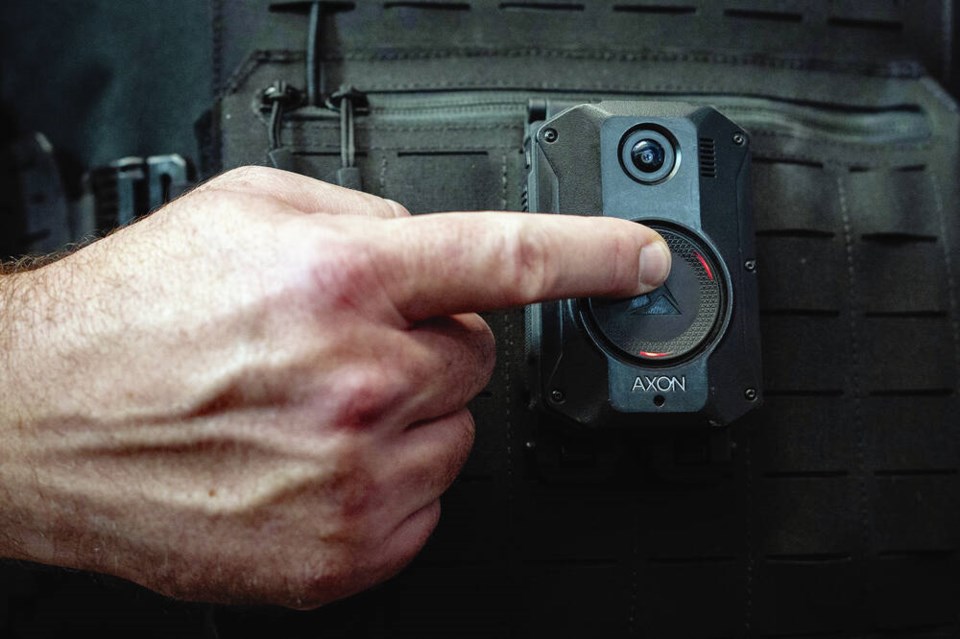SURREY — Police agencies in British Columbia say the introduction of body cameras will improve transparency and lead to more timely resolution of complaints against officers.
The B.C. Association of Chiefs of Police and representatives from several departments gathered at RCMP headquarters in Surrey on Thursday to tout the introduction of the cameras, soon to be worn by thousands of officers in the province and across Canada.
The association formed a committee in 2021, which was mandated “to identify best practices by ensuring consistency and standard operating procedures, policies, disclosure procedures and communications,” said Deputy Chief Anita Furlan with the Metro Vancouver Transit Police.
She said police expect the technology to improve interactions with the public and help resolve complaints more quickly.
Furlan, a vice-president with the B.C. Association of Chiefs of Police, said video evidence is valuable in court proceedings because it “shows exactly what is occurring.”
“A key principle for the committee was to ensure that using body-worn cameras balance the rights of the individual with the [use] of the technology,” she said.
The committee was also tasked with identifying “standard operating procedures” for the use of body cameras, and consult with other agencies “whose work will be impacted” by their introduction, the association said in a news release.
Evidence collected by the devices will be used not only by police, but also the B.C. Prosecution Service, which determines if charges will be laid, and by the Independent Investigations Office and the Office of the Police Complaint Commissioner, both police watchdog agencies.
Victoria Police Chief Del Manak said he welcomes the introduction of body cameras at VicPD to increase police transparency and accountability.
The department requested $150,000 last year to initiate a pilot, but Victoria and Esquimalt councils didn’t approve the request, along with several other budget items.
The police board has appealed the budget cuts to the province and is awaiting a response.
Manak said there are challenges around the use of body cameras, including privacy concerns for people unintentionally caught on camera and the cost of storing hundreds of hours of footage and extracting relevant sections when needed.
“I also think we just need to be cautious that we are not looking for an I.T. solution to a human problem,” Manak said, noting the officers who killed George Floyd in Minneapolis were wearing body cameras.
Manak said VicPD focuses on hiring the right officers with the right temperament, competencies and skills in de-escalation to limit issues around the use of force.
Chief Supt. Holly Turton of the RCMP said the force has used body cameras in a “limited capacity” since 2010, and between 10,000 and 15,000 body cameras are set to be deployed across Canada after field testing in Alberta and elsewhere.
Turton said the committee sought to “promote a collaborative approach among police agencies” about body camera implementation.
“Our intent was to ensure a seamless approach across the province with the understanding that this would also benefit the public and decision makers,” Turton said.
Supt. Howard Tran with the Vancouver Police Department said introducing body cameras is “long overdue,” as communities have changed their expectations of police at a time of “emerging public safety challenges.”
Dozens of VPD officers are already wearing body cameras under a pilot program launched last week.
Sgt. Jim Ingram, the Delta Police Department’s body-worn camera co-ordinator, said the decision to turn on cameras is up to an officer’s discretion if they decide a recording could have “evidentiary value.”
Ingram said policing standards, though, require cameras to be turned on “if there is a potential for use of force or violent or aggressive behaviour is anticipated or displayed.”
He said the cameras “assist in de-escalating” potentially volatile situations, and video evidence of an event is superior to handwritten notes.
He said the cameras are an “additional tool” officers can use to defuse tense situations as people behave differently when they know they’re being recorded.
“When there’s a camera turned on, I’d say that everybody has a little bit of a psychological switch that flips,” he said. “I think that’s just human nature.”
The Delta Police Department has been using the cameras for about two years, and currently 21 are in operation with 16 more to be introduced this year.
At an unrelated news conference Thursday, Premier David Eby said the police cameras help provide valuable evidence and ensure accountability.
“When police are conducting themselves in public, with all the authorities and powers that they have, when they are doing it on camera it’s reassurance to the public that they’re doing it in as professional a way as possible,” Eby said, adding the body-worn cameras have advantages for police and the public.
“Certainly, I’m supportive.”



